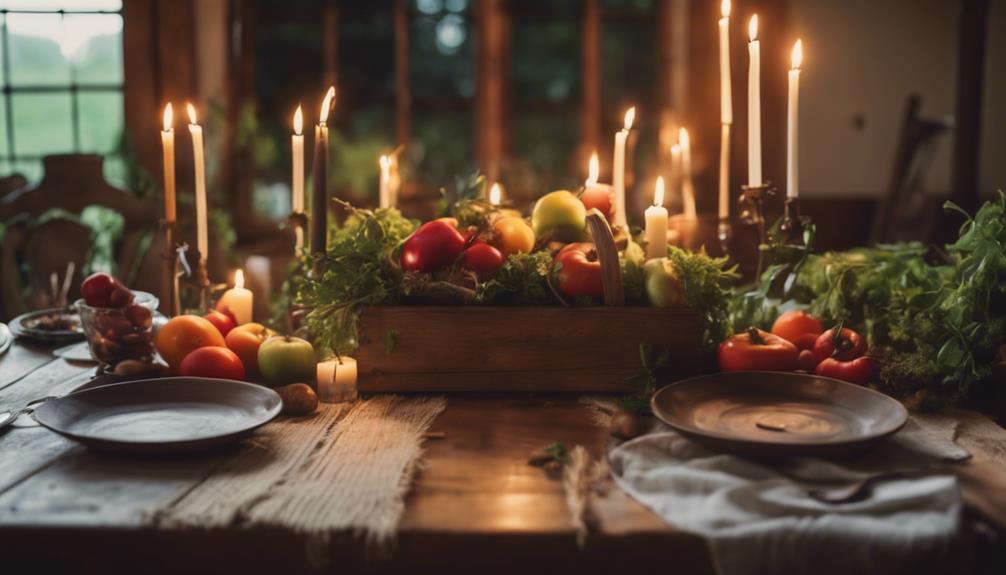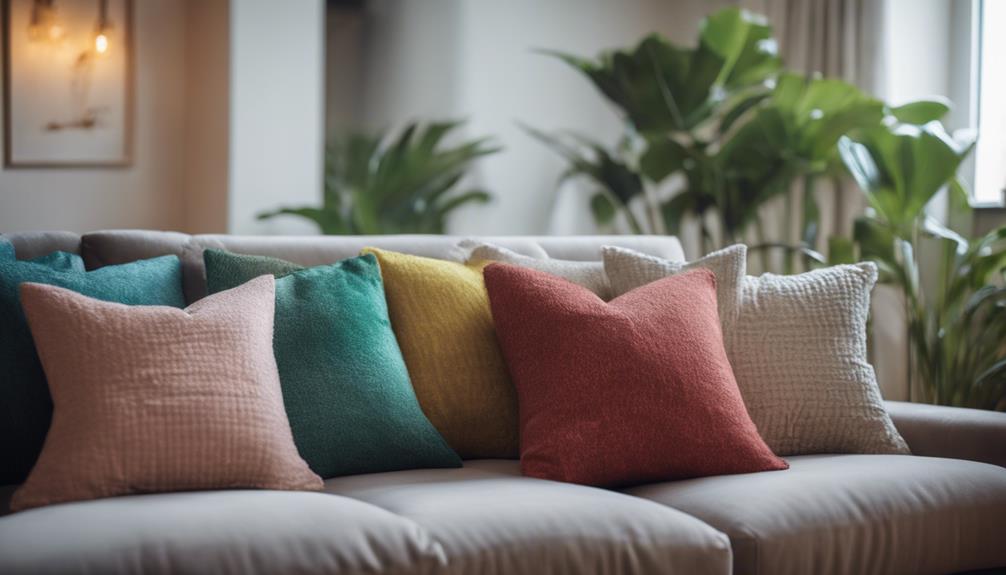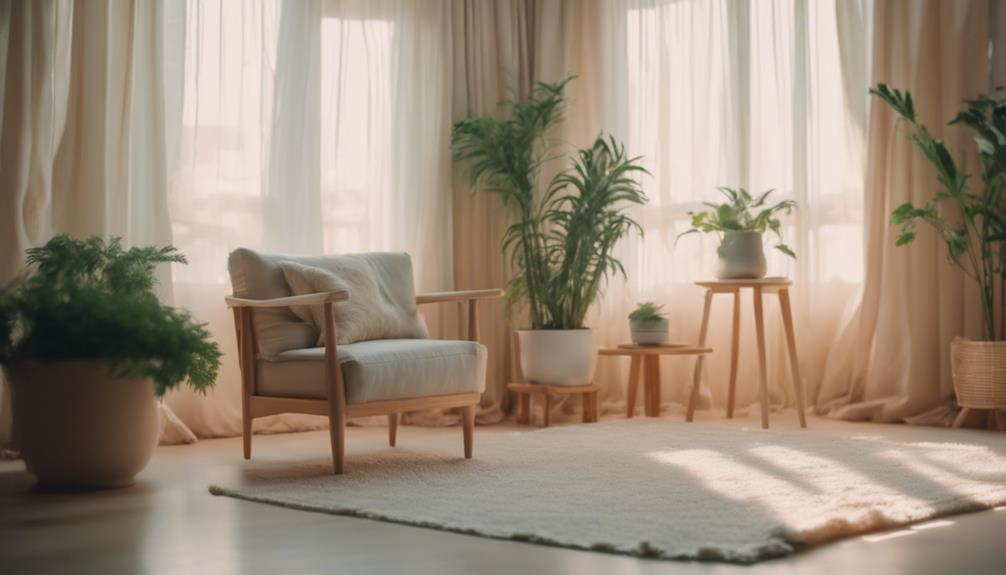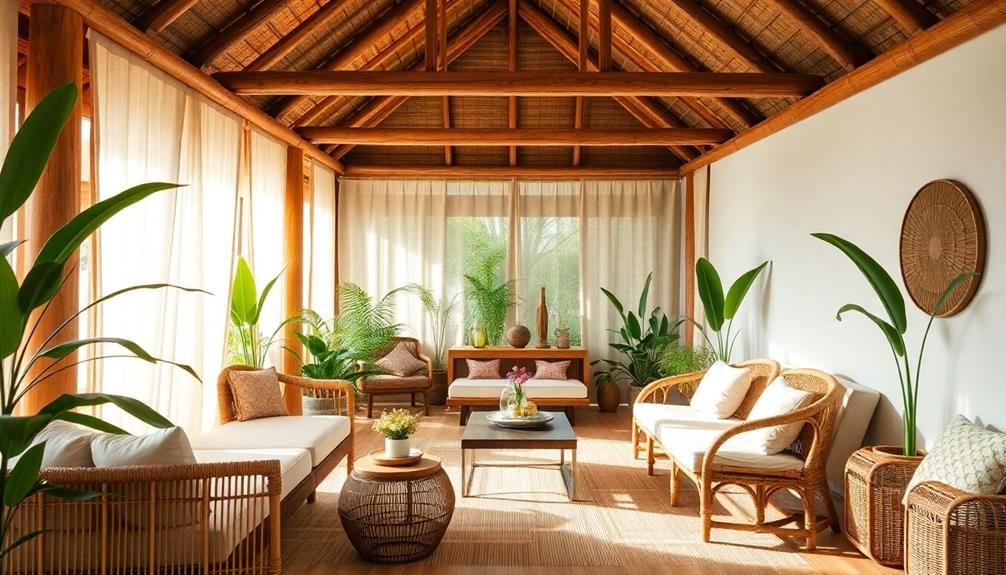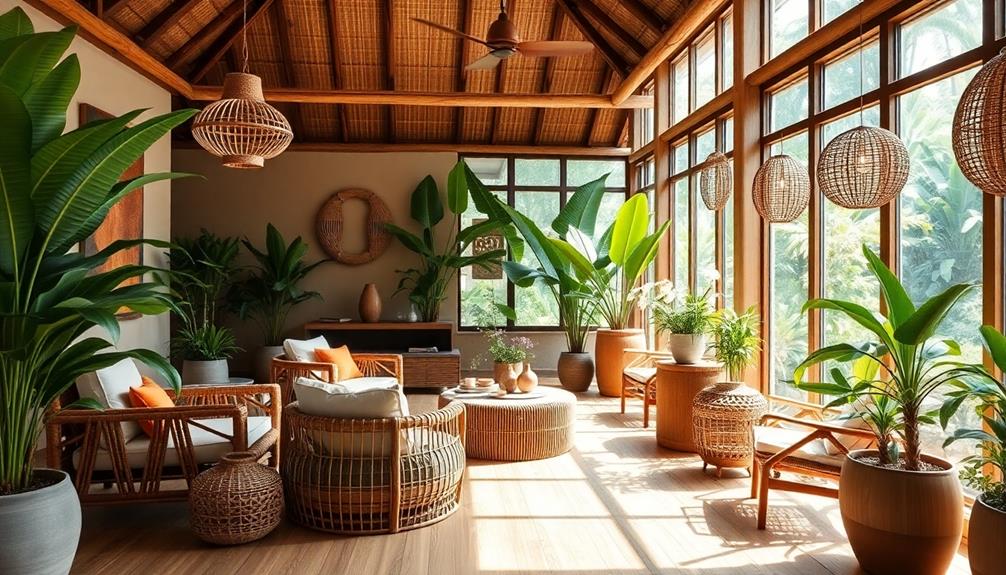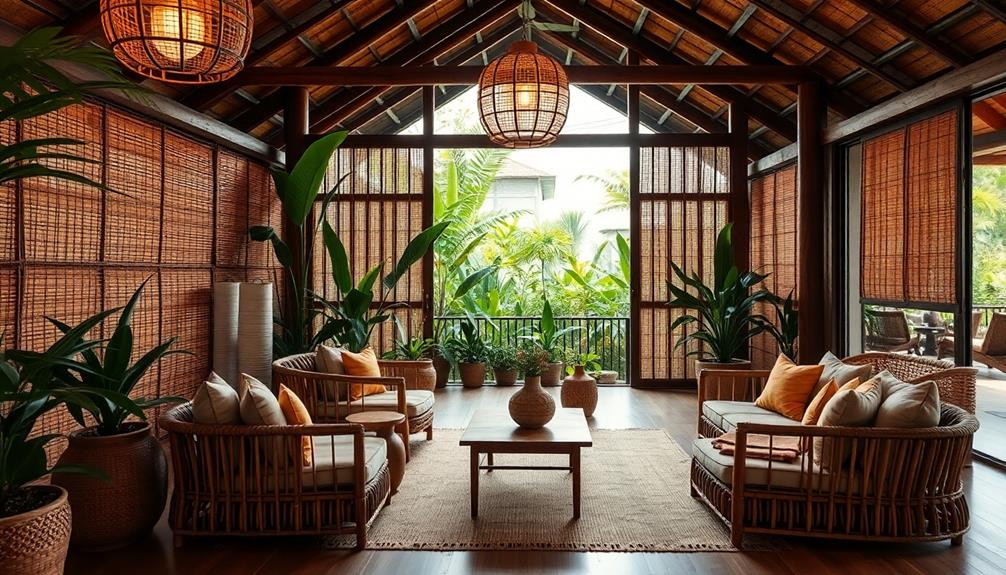Embracing Indonesian aesthetics in modern spaces enhances your environment with vibrant colors and intricate designs that tell rich cultural stories. You'll find the harmony of traditional craftsmanship fused with modern functionality, creating spaces that feel both alive and serene. Natural materials like wood and bamboo not only promote sustainability but also invite a connection to nature. These design elements bring a unique ambiance that encourages creativity and tranquility. Plus, incorporating Indonesian styles demonstrates a global appreciation for diverse cultures. There's a lot more about how to make these aesthetics work for you.
Key Takeaways
- Embracing Indonesian aesthetics enhances modern spaces with rich cultural heritage, promoting appreciation for unique artistic expressions and narratives.
- The use of natural materials like wood and bamboo fosters sustainability while creating visually appealing and environmentally friendly environments.
- Incorporating traditional textiles and craftsmanship adds depth and authenticity, connecting contemporary designs to Indonesia's rich history and cultural significance.
- Open-air design principles improve ventilation and tranquility, creating calming atmospheres that enhance well-being in modern living spaces.
- Indonesian design encourages ecological responsibility and environmentally conscious choices, aligning with a global community valuing sustainable practices.
Cultural Significance of Indonesian Aesthetics

What makes Indonesian aesthetics so culturally significant? It's rooted in a rich cultural heritage that's evolved over centuries, influenced by indigenous practices, Hinduism, and colonial histories.
When you explore Indonesian aesthetics, you see how they reflect diverse artistic expressions, from traditional architecture like Rumah Gadang to the stunning Tongkonan. These structures emphasize community and spirituality, showcasing intricate carvings that tell stories of the past.
Additionally, the use of vibrant colors and intricate patterns in decor, such as decorative pillows, further enhances the cultural narrative found in these spaces.
Incorporating elements of Indonesian aesthetics into modern spaces creates a unique blend of history and contemporary design. The use of natural materials and vibrant color palettes fosters a sense of tranquility and connection to nature.
You'll find that these design choices promote harmony, making your living environment feel more alive and meaningful.
Moreover, embracing Indonesian aesthetics doesn't just enhance your space; it also deepens your appreciation for cultural identity. As you create modern spaces infused with this heritage, you highlight the importance of sustainability and environmental consciousness in design.
Key Elements of Indonesian Design

Throughout history, Indonesian design has embraced a harmonious blend of natural materials and cultural motifs that resonate deeply with the environment.
You'll find that natural materials like wood, stone, bamboo, and rattan form the backbone of many spaces, promoting sustainability while fostering a strong connection to nature.
Additionally, traditional artistry in masks adds a unique touch to your decor, enhancing the overall aesthetic appeal.
In your interior design, consider incorporating traditional textiles such as batik and ikat. These fabrics showcase intricate patterns that tell stories and add a cultural significance to your decor.
Open-air design principles are also key, blurring the lines between indoor and outdoor spaces.
This approach enhances ventilation and fosters tranquility, making your home feel more expansive and connected to the outdoors.
Elements like thatched roofs made from alang-alang grass not only provide insulation but also reflect local architectural traditions, adding charm to your space.
When choosing colors, gravitate toward earthy tones accented by vibrant hues.
This color palette symbolizes purity, prosperity, and a deep connection to the natural world, perfectly complementing your Indonesian modern art pieces.
Blending Tradition With Modernity

When you think about blending tradition with modernity in Indonesian aesthetics, consider how cultural heritage can be seamlessly integrated into innovative design practices.
By using traditional materials and techniques, such as natural materials like wood and stone, you can create spaces that honor the past while embracing contemporary needs.
This approach not only enhances the visual appeal but also fosters a deeper connection to Indonesia's rich history and craftsmanship.
Cultural Heritage Integration
Blending tradition with modernity creates a vibrant tapestry of Indonesian aesthetics that enriches contemporary spaces. By incorporating elements from Indonesia's rich cultural heritage, such as unique artistic expressions found in Indonesian decor masks, you can transform your environment into a unique fusion of traditional and modern design.
For instance, consider integrating intricate carvings and natural materials like wood and stone, which ground your space while telling a story of local craftsmanship. Architectural styles such as Rumah Gadang and Tongkonan offer a glimpse into indigenous narratives that can seamlessly fit into modern contexts, preserving local identity.
Balinese interior design principles emphasize open-air layouts, connecting indoor and outdoor spaces, perfect for embracing Indonesia's tropical climate while enhancing your living experience. Moreover, using traditional textiles like batik and ikat in your decor not only supports local artisans but also adds depth and cultural significance to your interiors.
Innovative Design Practices
Integrating innovative design practices into modern spaces allows you to celebrate Indonesia's rich heritage while embracing contemporary aesthetics. By focusing on a harmonious blend of traditional elements and modern functionalities, you can create an environment that reflects both cultural significance and stylish living.
For instance, incorporating traditional batik patterns can enhance the visual appeal of your decor, adding a unique touch to modern designs traditional textile inspiration.
Here are three key elements to contemplate:
- Natural Materials: Use wood, stone, and bamboo to enhance sustainability while honoring Indonesian craftsmanship. These materials not only add warmth but also connect your space to nature.
- Textile Integration: Incorporate traditional textiles like batik and ikat into your décor. These fabrics not only provide a unique cultural flair but also serve as striking focal points that enhance contemporary art.
- Open-Air Layouts: Embrace Balinese design principles by blurring the lines between indoor and outdoor living. This promotes natural ventilation and creates a serene atmosphere, ideal for modern lifestyles.
Innovative designs often feature water elements, like ponds or fountains, which are essential to Indonesian culture. By incorporating these practices, you can achieve a modern space that's not only aesthetically pleasing but also rich in history and identity.
Impact on Contemporary Spaces

In recent years, the impact of Indonesian aesthetics on contemporary spaces has become increasingly evident. By integrating natural materials and traditional textiles, you enhance the sensory experience, creating a unique and inviting atmosphere.
The use of architectural elements like thatched roofs and elevated designs not only preserves cultural heritage but also inspires innovative and sustainable modern designs. Significantly, luxury tropical design aesthetics can elevate the overall ambiance of a space, making it feel more welcoming and serene.
Incorporating intricate patterns, especially from Balinese design, instills a sense of tranquility and luxury, making your contemporary spaces feel more grounded. The earthy color palette characteristic of this style further contributes to that calming effect.
Additionally, embracing open-air design principles encourages seamless indoor-outdoor connections, promoting natural ventilation and light, which are essential in modern architecture.
Integrating nature-inspired elements like tropical greenery and water features not only enhances the ambiance but also encourages peace and relaxation. This connection to Indonesia's rich natural environment transforms contemporary spaces into serene retreats, allowing you to escape the hustle and bustle of everyday life.
Nature and Sustainability in Design

Emphasizing nature and sustainability in design not only enhances the aesthetic appeal of modern spaces but also fosters a deeper connection to the environment.
By incorporating elements inspired by Indonesian aesthetics, such as the use of Traditional Indonesian Style Home Decor that features intricate carvings and natural materials, you can create a harmonious atmosphere that values both beauty and ecological responsibility.
Here are three key aspects to reflect upon:
- Natural Materials: Use wood, stone, bamboo, and rattan to promote sustainability. These materials not only look stunning but also connect your space to the natural world.
- Open-Air Designs: Embrace designs that blur the lines between indoor and outdoor spaces. This enhances ventilation and natural light, making your home more energy-efficient while inviting the beauty of the outdoors in.
- Tropical Greenery: Integrate indoor plants and water features to purify the air and create calming atmospheres. This not only enhances aesthetic appeal but also promotes mental well-being.
Global Influence and Recognition

Indonesian aesthetics have captured global attention, showcasing a vibrant blend of traditional craftsmanship and modern design elements. This unique combination, especially evident in Balinese interior design, emphasizes natural materials and open spaces, creating a warm and inviting atmosphere.
The intricate designs of Indonesian decor masks further highlight the rich cultural heritage, adding depth and character to any space. The global influence of Indonesian art is undeniable, as artists participate in international exhibitions, fostering cross-cultural exchanges that celebrate local identity while engaging with global trends.
Prominent designers like Made Wijaya have played an essential role in elevating Indonesian aesthetics in the global market, successfully merging traditional techniques with contemporary innovations. Their work highlights the importance of sustainable practices in architecture, resonating with environmentally conscious consumers worldwide.
As you explore modern spaces, you'll find a growing demand for Indonesian-inspired designs, reflecting a broader trend of incorporating diverse cultural elements into design narratives.
This rising interest in Indonesia's rich cultural heritage not only enhances your living space but also connects you to a global community that values authenticity and sustainability.
Frequently Asked Questions
Why Is the Aesthetic Movement Important?
The Aesthetic Movement's importance lies in its emphasis on beauty, emotional connection, and craftsmanship. It encourages you to appreciate art and design as expressions of personal identity, creating spaces that resonate with tranquility and cultural heritage.
What Is the Art Style of Indonesia?
When you explore Indonesia's art style, you'll see vibrant batik patterns and intricate wood carvings. This blend of traditional and contemporary elements creates a rich tapestry that reflects Indonesia's diverse cultural heritage and modern influences.
What Trend Developed in Indonesian Painting After the 19TH Century?
After the 19th century, you'll notice Indonesian painting embraced modernism, as artists like Hendra Gunawan and Affandi rejected colonial sentiments, focusing instead on national identity and contemporary socio-political issues, reflecting their unique cultural narratives.
What Is the Importance of Aesthetics and What Role Does It Play in the Creation of Art?
Aesthetics shapes your emotional connection to art, guiding how you perceive beauty. It influences artists' choices in color and form, creating deeper interactions and reflections of culture, ultimately enriching your appreciation and understanding of their work.
Conclusion
Embracing Indonesian aesthetics in modern spaces isn't just about beauty; it's a celebration of culture and sustainability. Did you know that Indonesia is home to over 300 distinct ethnic groups, each with its unique design elements? By incorporating these diverse influences, you're not only enriching your environment but also fostering a deeper appreciation for global heritage. So, let's blend tradition with modernity and create spaces that resonate with both history and contemporary life.


